A Novel Framework for Optimizing Indoor Illuminance and Discovering Association of Involved Variables
Abstract
1. Introduction
2. Materials and Methods
2.1. Experimental Settings
2.2. The Proposed Framework—Stage 1
2.3. The Proposed Framework—Stage 2
- A dependent variable is selected from the visual comfort and maximum visual comfort calculations of Equation (9).
- An independent variable is chosen from active variables or environmental variables.
- Other input variables are fixed at specific values.
3. Results
4. Conclusions
Author Contributions
Funding
Institutional Review Board Statement
Informed Consent Statement
Data Availability Statement
Conflicts of Interest
References
- Aksamija, A. Design methods for sustainable, high-performance building facades. Adv. Build. Energy Res. 2015, 10, 240–262. [Google Scholar] [CrossRef]
- Grobman, Y.J.; Capeluto, I.G.; Austern, G. External shading in buildings: Comparative analysis of daylighting performance in static and kinetic operation scenarios. Arch. Sci. Rev. 2017, 60, 126–136. [Google Scholar] [CrossRef]
- Wagdy, A.; Fathy, F.; Altomonte, S. Evaluating the daylighting performance of dynamic facades by using new annual climate-based metrics. Proceeding of the 36th International Conference on Passive and Low Energy Architecture, Los Angeles, CA, USA, 11–13 July 2016. [Google Scholar]
- Selkowitz, S.E.; Aschehoug, Ø.; Lee, E.S. Advanced interactive facade: Critical elements for future green buildings. In Proceedings of the GreenBuild, the Annual USGBC International Conference and Expo, Philadelphia, PA, USA, 20–22 November 2013. [Google Scholar]
- Kim, K.; Jerratt, C. Energy performance of an adaptive facade system. J. Archit. Res. 2011, 179–186. [Google Scholar] [CrossRef]
- Sørensen, L.S. Heat Transmission Coefficient Measurements in Buildings Utilizing a Heat Loss Measuring Device. Sustainability 2013, 5, 3601–3614. [Google Scholar] [CrossRef]
- Veliko, K.; Thun, G. Responsive Building Envelopes: Characteristics and Evolving Paradigms in Design and Construction of High-Performance Homes; Routledge Press: New York, NY, USA, 2013. [Google Scholar]
- Heidari Matin, N.; Eydgahi, A.; Shyu, S.; Matin, P. Evaluating visual comfort metrics of responsive facade systems as educational activities. Proceeding of the ASEE Annual Conference & Exposition Proceedings, Salt Lake City, UT, USA, 23–27 July 2018. [Google Scholar] [CrossRef]
- Matin, N.H.; Eydgahi, A. Technologies used in responsive facade systems: A comparative study. Intell. Build. Int. 2019, 14, 54–73. [Google Scholar] [CrossRef]
- Heidari Matin, N.; Eydgahi, A.; Shyu, S. Comparative analysis of technologies used in responsive building facades. In Proceedings of the ASEE Annual Conference & Exposition Proceedings, Columbus, OH, USA, 24–27 June 2018. [Google Scholar]
- Zemella, G.; Faraguna, A. Evolutionary Optimization of Facade Design; Springer: London, UK, 2014. [Google Scholar] [CrossRef]
- Loonen, R.C.G.M.; Trčka, M.; Cóstola, D.; Hensen, J.L.M. Climate adaptive building shells: State-of-the-art and future challenges. Renew. Sustain. Energy Rev. 2013, 25, 483–493. [Google Scholar] [CrossRef]
- Shan, R. Climate Responsive Facade Optimization Strategy. Ph.D. Dissertation, University of Michigan, Ann Arbor, MI, USA, 2016. [Google Scholar]
- Matin, N.H.; Eydgahi, A. A data-driven optimized daylight pattern for responsive facades design. Intell. Build. Int. 2021, 1–12. [Google Scholar] [CrossRef]
- Shan, R.; Junghans, L. “Adaptive radiation” optimization for climate adaptive building facade design strategy. Build. Simul. 2018, 11, 269–279. [Google Scholar] [CrossRef]
- Ochoa, C.E.; Capeluto, I.G. Evaluating visual comfort and performance of three natural lighting systems for deep office buildings in highly luminous climates. Build. Environ. 2006, 41, 1128–1135. Available online: https://www.academia.edu/3090660/Evaluating_visual_comfort_and_performance_of_three_natural_lighting_systems_for_deep_office_buildings_in_highly_luminous_climates (accessed on 12 June 2022). [CrossRef]
- Reinhart, C.F.; Walkenhorst, O. Validation of dynamic RADIANCE-based daylight simulations for a test office with external blinds. Energy Build. 2001, 33, 683–697. [Google Scholar] [CrossRef]
- Ng, E.Y.-Y.; Poh, L.K.; Wei, W.; Nagakura, T. Advanced lighting simulation in architectural design in the tropics. Autom. Constr. 2001, 10, 365–379. [Google Scholar] [CrossRef]
- Yoon, Y.; Moon, J.W.; Kim, S. Development of annual daylight simulation algorithms for prediction of indoor daylight illuminance. Energy Build. 2016, 118, 1–17. [Google Scholar] [CrossRef]
- Reinhart, C.F.; Andersen, M. Development and validation of a Radiance model for a translucent panel. Energy Build. 2006, 38, 890–904. [Google Scholar] [CrossRef]
- Reinhart, C.F.; Jakubiec, A.; Ibarra, R. Definition of a reference office for standardized evaluations of dynamic facade and lighting technologies. Proc. Build. Simul. 2013, 5, 560–580. [Google Scholar]
- Mardaljevic, J. Validation of a lighting simulation program under real sky conditions. Light. Res. Technol. 1995, 27, 181–188. [Google Scholar] [CrossRef]
- Mardaljevic, J. Daylight Simulation: Validation, Sky Models and Daylight Coefficients. Ph.D. Thesis, De Montfort University, Leicester, UK, 2000. [Google Scholar]
- Mardaljevic, J. The BRE-IDMP dataset: A new benchmark for the validation of illuminance prediction techniques. Light. Res. Technol. 2001, 33, 117–134. [Google Scholar] [CrossRef]
- Mardaljevic, J. Verification of program accuracy for illuminance modelling: Assumptions, methodology and an examination of conflicting findings. Light. Res. Technol. 2004, 36, 217–239. [Google Scholar] [CrossRef]
- Gharipour, A.; Liew, A.W.-C. An integration strategy based on fuzzy clustering and level set method for cell image segmentation. In Proceedings of the 2013 IEEE International Conference on Signal, Communication and Computing, KunMing, China, 5–8 August 2013. [Google Scholar] [CrossRef]
- Gharipour, A.; Liew, A.W.-C. Level set-based segmentation of cell nucleus in fluorescence microscopy images using correntropy-based K-means clustering. In Proceedings of the 2015 International Conference on Digital Image Computing: Techniques and Applications (DICTA), Adelaide, Australia, 23–25 November 2015. [Google Scholar] [CrossRef]
- Pacific Northwest National Laboratory (NPPL). U.S. Department of Energy, Annual Site Environmental Report; The U.S. Department of Energy: Oak Ridge, TN, USA, 2015; p. 155.
- Lorenz, C.-L.; Packianather, M.; Spaeth, A.B.; De Souza, C.B. Artificial Neural Network-Based Modelling for Daylight Evaluations. In Proceedings of the SimAUD 2018, Delft, The Netherlands, 4–7 June 2018; 2018; Volume 2, pp. 1–8. [Google Scholar] [CrossRef][Green Version]
- Yi, H.; Kim, M.-J.; Kim, Y.; Kim, S.-S.; Lee, K.-I. Rapid Simulation of Optimally Responsive Façade during Schematic Design Phases: Use of a New Hybrid Metaheuristic Algorithm. Sustainability 2019, 11, 2681. [Google Scholar] [CrossRef]
- Trakhtenbrot, B. A Survey of Russian Approaches to Perebor (Brute-Force Searches) Algorithms. IEEE Ann. Hist. Comput. 1984, 6, 384–400. [Google Scholar] [CrossRef]
- Tabadkani, A.; Banihashemi, S.; Hosseini, M.R. Daylighting and visual comfort of oriental sun responsive skins: A parametric analysis. Build. Simul. 2018, 11, 663–676. [Google Scholar] [CrossRef]
- Reinhart, C.F.; Weissman, D.A. The daylit area—Correlating architectural student assessments with current and emerging daylight availability metrics. Build. Environ. 2012, 50, 155–164. [Google Scholar] [CrossRef]
- Nabil, A.; Mardaljevic, J. Useful daylight illuminances: A replacement for daylight factors. Energy Build. 2006, 38, 905–913. [Google Scholar] [CrossRef]
- Nabil, A.; Mardaljevic, J. Useful daylight illuminance: A new paradigm for assessing daylight in buildings. Light. Res. Technol. 2005, 37, 41–57. [Google Scholar] [CrossRef]
- Chauvel, P.; Collins, J.; Dogniaux, R.; Longmore, J. Glare from windows: Current views of the problem. Light. Res. Technol. 1982, 14, 31–46. [Google Scholar] [CrossRef]
- Ostertagová, E.; Ostertag, O. Methodology and Application of One-way ANOVA. Am. J. Mech. Eng. 2013, 1, 256–261. [Google Scholar] [CrossRef]
- Wong, A.; Wong, S. A Cross-Cohort Exploratory Study of a Student Perceptions on Mobile Phone-Based Student Response System Using a Polling Website. Int. J. Educ. Dev. Using Inf. Commun. Technol. 2016, 12, 58–78. [Google Scholar]
- Hailemeskel Abebe, T. The Derivation and Choice of Appropriate Test Statistic (Z, t, F and Chi-Square Test) in Research Methodology. Math. Lett. 2019, 5, 33–40. [Google Scholar] [CrossRef]
- R Core Team. R: A Language and Environment for Statistical Computing; R Foundation for Statistical Computing: Vienna, Austria, 2014; Available online: http://www.R-project.org/ (accessed on 12 June 2022).

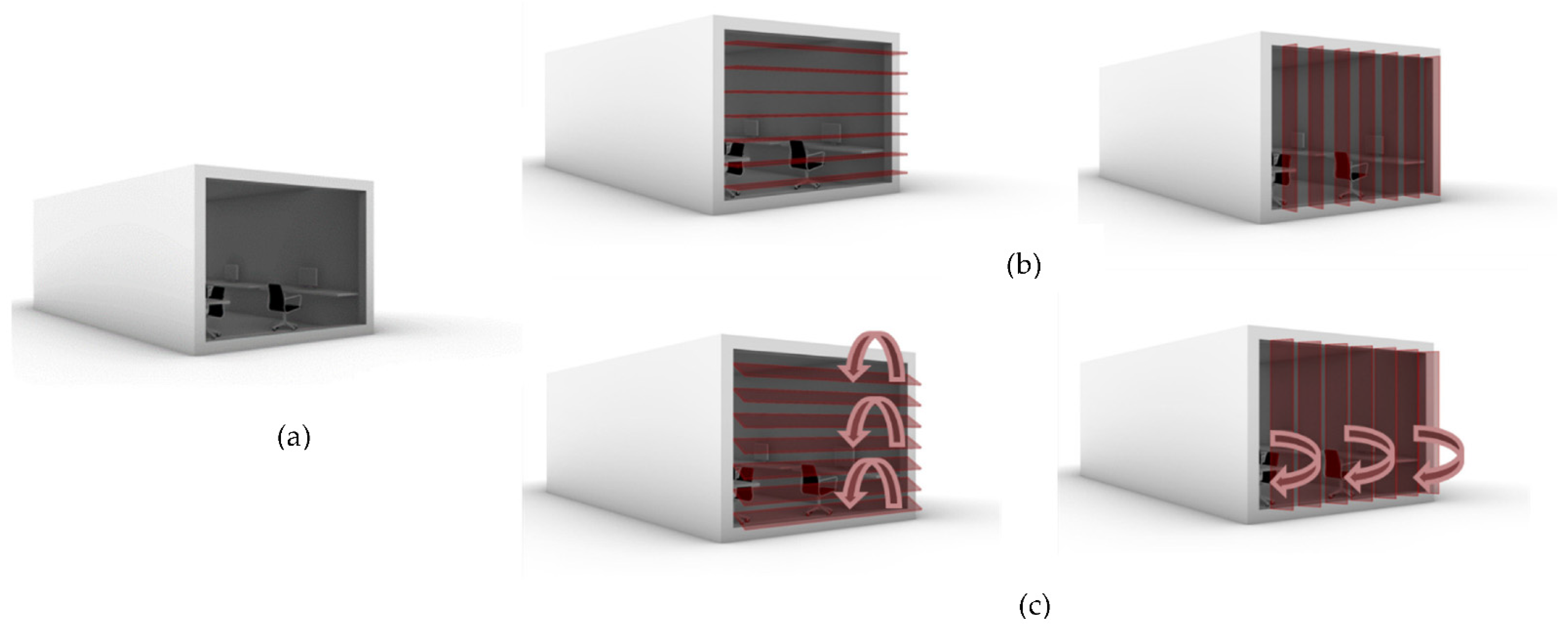
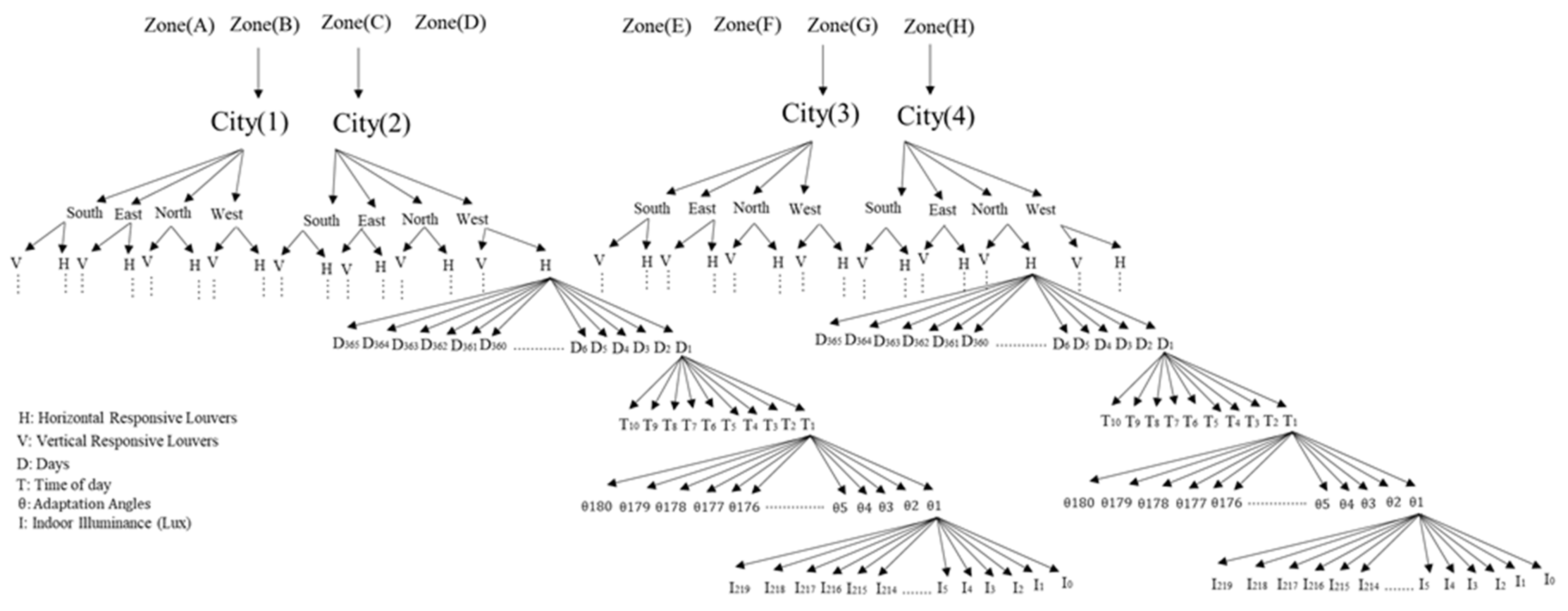
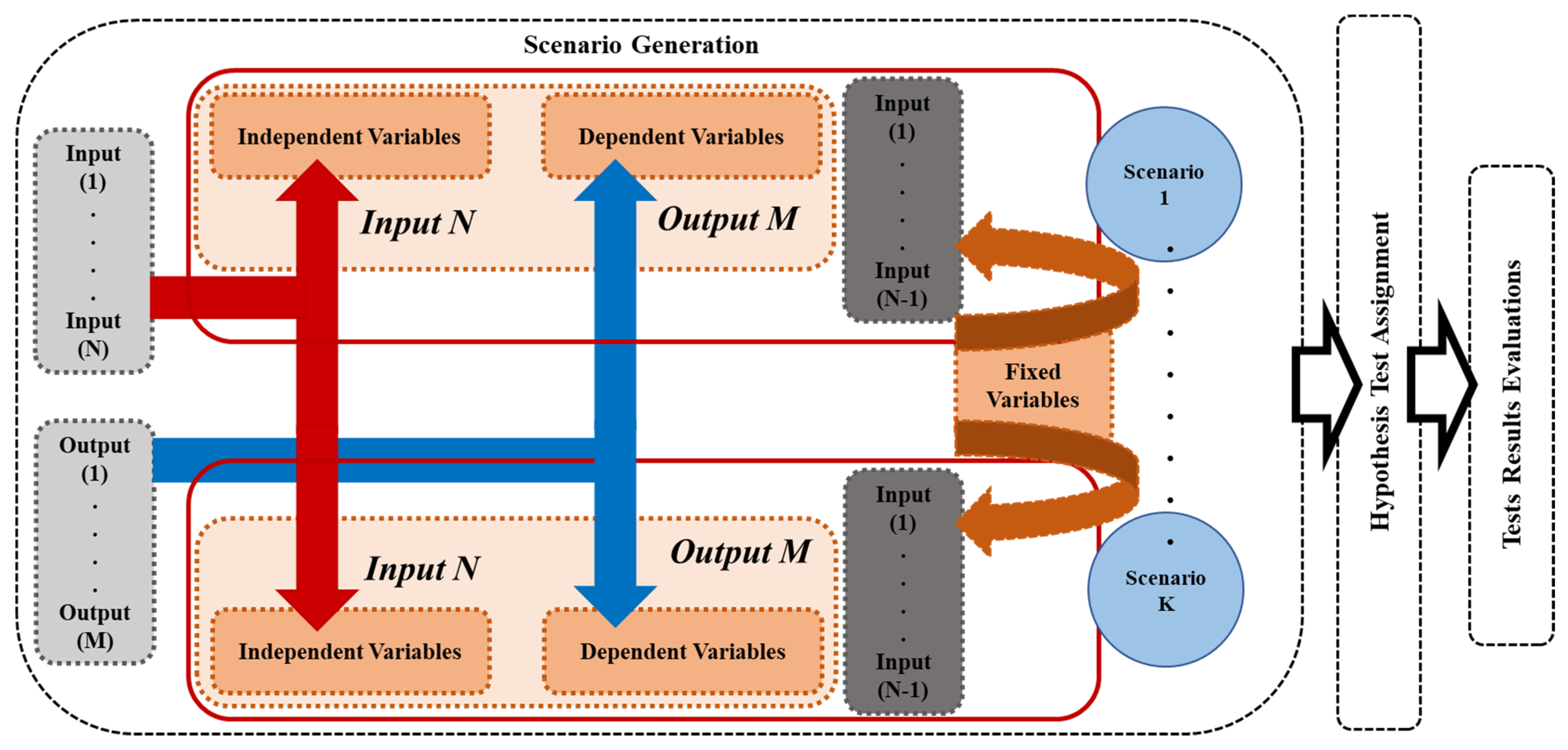
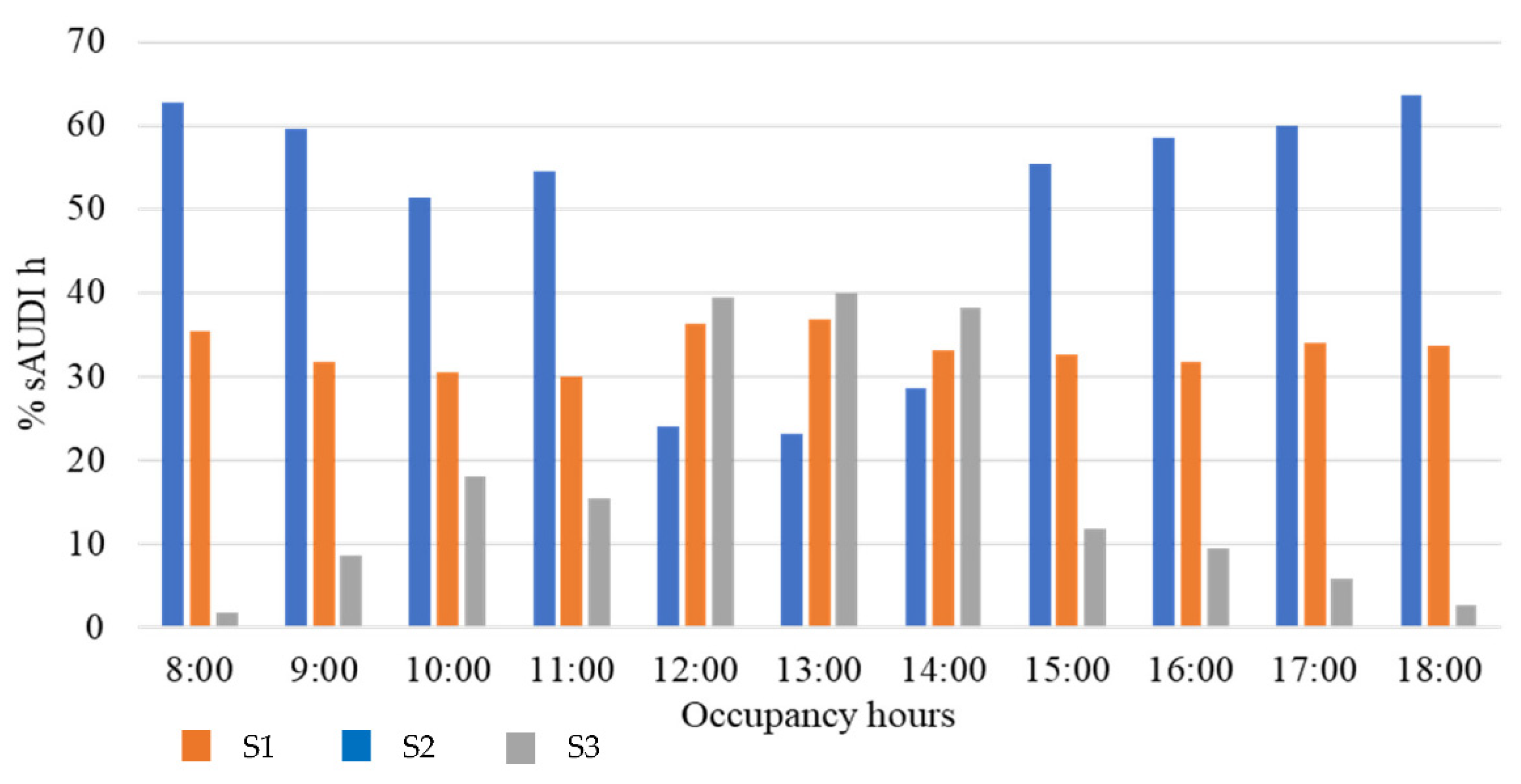
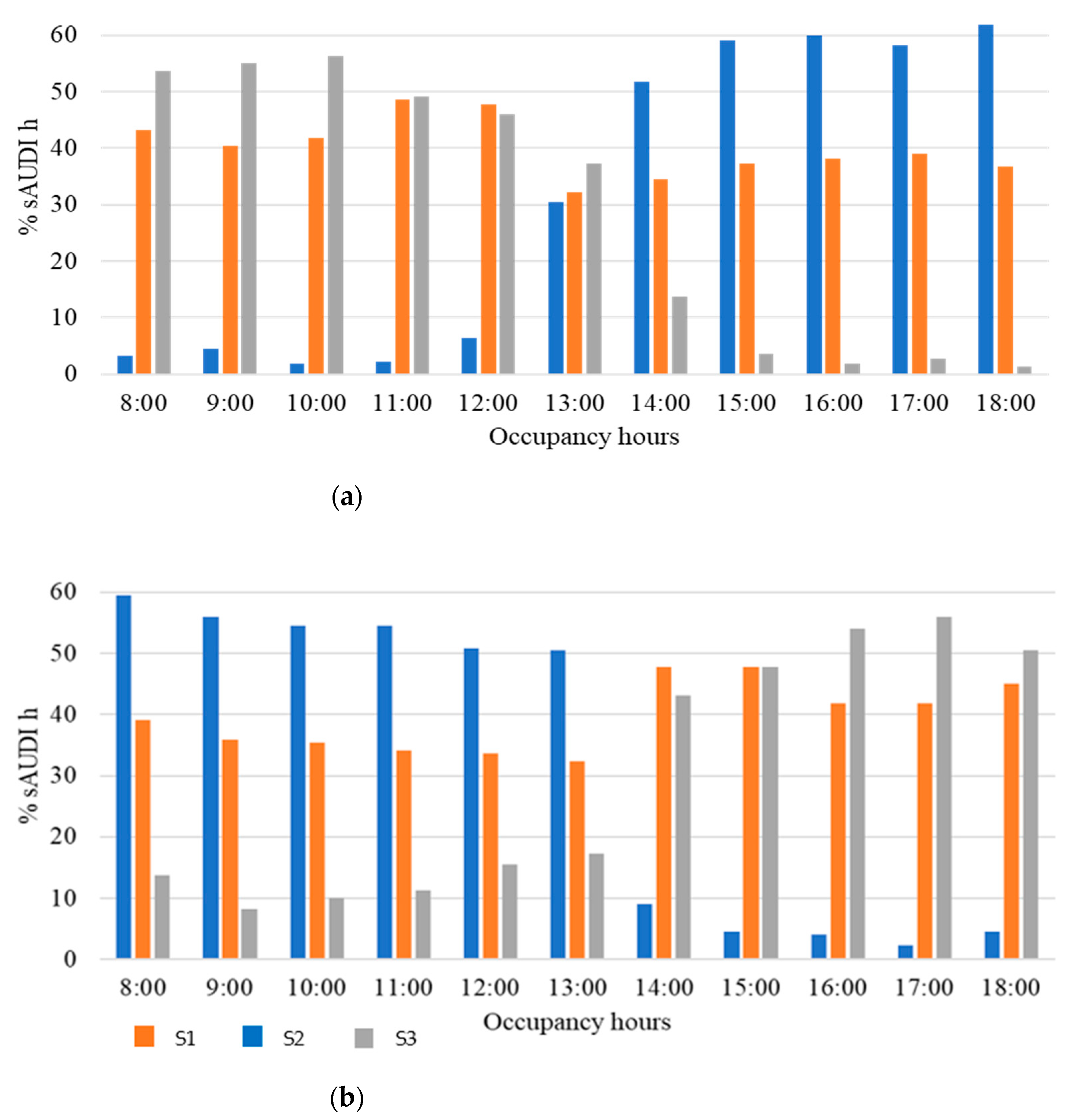
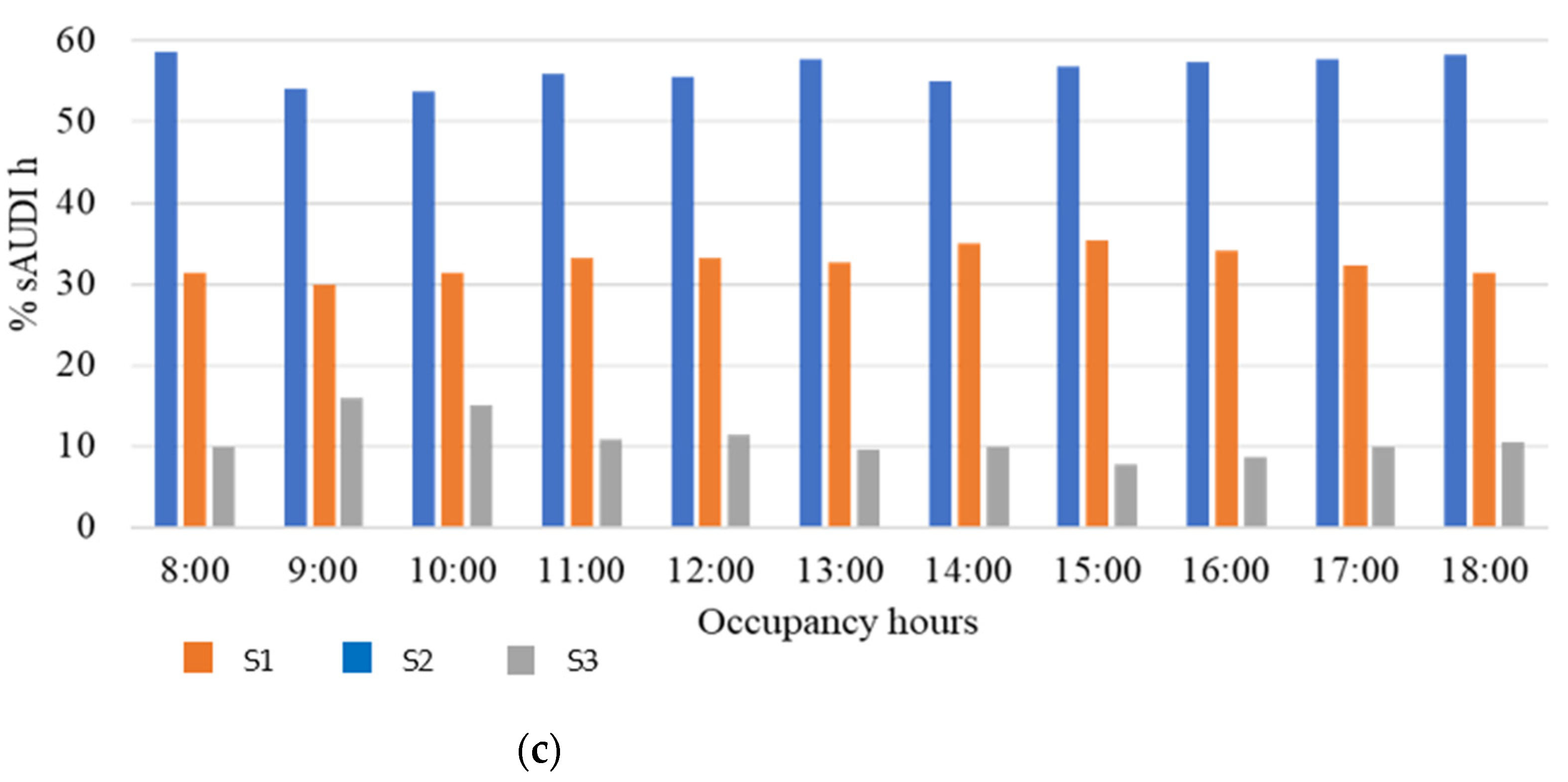
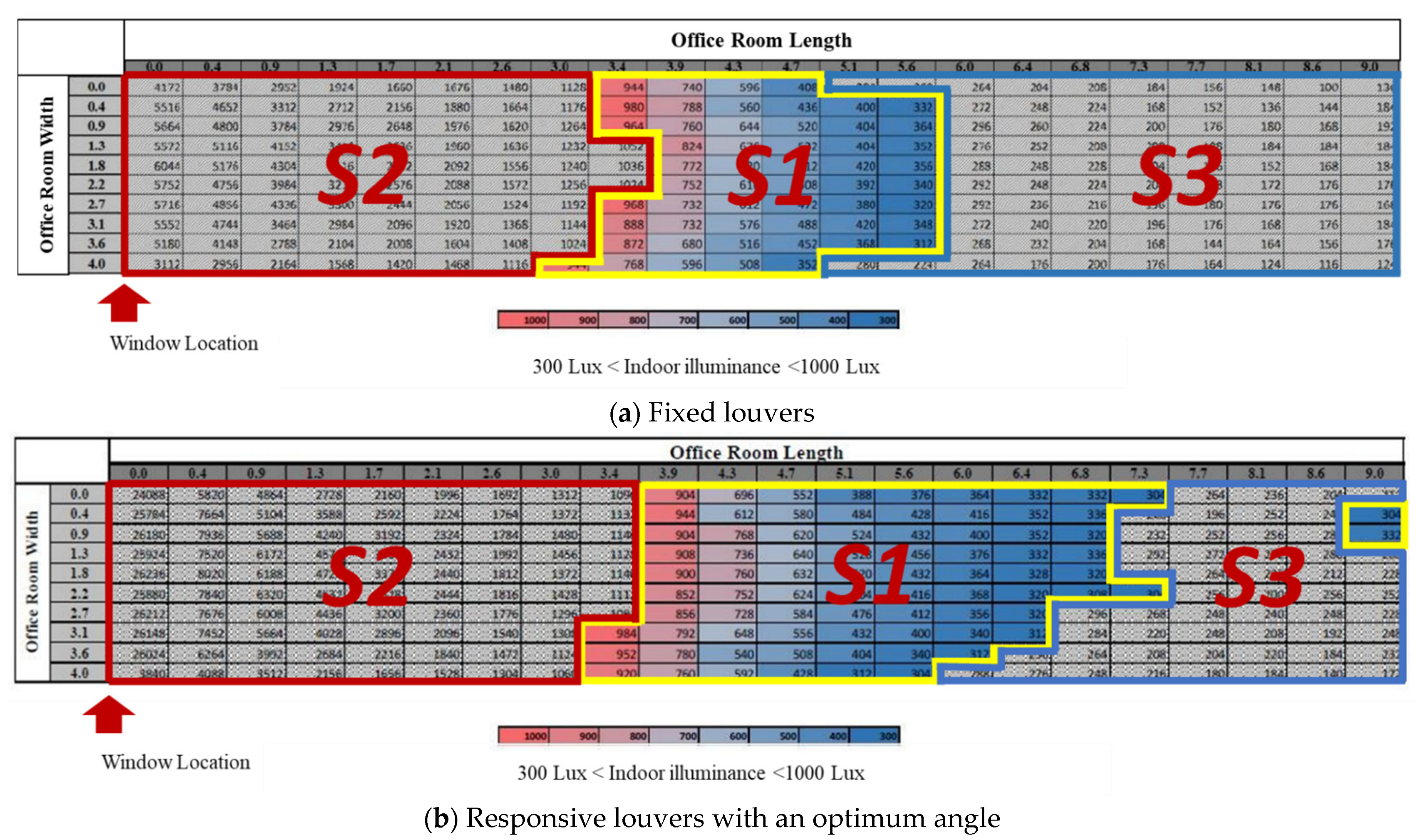
| Independent Variable | Dependent Variable | Fixed Variables | Assigned Test | Scenarios |
|---|---|---|---|---|
| Fixed facade and Responsive facade with Adaptation angle | Visual comfort metric—UDIh | City Rotational Motion Orientation Month of the year | One-way ANOVA | 384 |
| Horizontal louvers and Vertical louvers | Visual comfort metric—UDIh | City Orientation Month of the year | One-way ANOVA | 192 |
| Building orientation | Max visual comfort | City Rotational Motion Month of the year | Kruskal–Wallis | 96 |
| Positive angles and negative angles | Max visual comfort | City Rotational Motion Orientation | Chi squared | 32 |
| June-21st-Horizontal Facade-Phoenix | ||||||||||||||||
|---|---|---|---|---|---|---|---|---|---|---|---|---|---|---|---|---|
| Orientations | South | East | North | West | ||||||||||||
| %sAUDIh | %sAUDIh | %sAUDIh | %sAUDIh | |||||||||||||
| Hours | Opt. Angle | s1 | s2 | s3 | Opt. Angle | s1 | s2 | s3 | Opt. Angle | s1 | s2 | s3 | Opt. Angle | s1 | s2 | s3 |
| 8:00 | 43 | 35.455 | 62.727 | 1.818 | 75 | 43.182 | 3.182 | 53.636 | −46 | 31.364 | 58.636 | 10.000 | −49 | 39.091 | 59.545 | 13.64 |
| 9:00 | 40 | 31.818 | 59.545 | 8.636 | 80 | 40.455 | 4.545 | 55.000 | −43 | 30.000 | 54.091 | 15.909 | −46 | 35.909 | 55.909 | 8.182 |
| 10:00 | 40 | 30.455 | 51.364 | 18.182 | −53 | 41.818 | 1.818 | 56.364 | −43 | 31.364 | 53.636 | 15.000 | −46 | 35.455 | 54.545 | 10.000 |
| 11:00 | 44 | 30.000 | 54.545 | 15.455 | −60 | 48.636 | 2.273 | 49.091 | −40 | 33.182 | 55.909 | 10.909 | −44 | 34.091 | 54.545 | 11.364 |
| 12:00 | 32 | 36.364 | 24.091 | 39.545 | −63 | 47.727 | 6.364 | 45.909 | −46 | 33.182 | 55.455 | 11.364 | −46 | 33.636 | 50.909 | 15.455 |
| 13:00 | −32 | 36.818 | 23.182 | 40.000 | −60 | 32.273 | 30.455 | 37.273 | −44 | 32.727 | 57.727 | 9.545 | −46 | 32.273 | 50.455 | 17.273 |
| 14:00 | −26 | 33.182 | 28.636 | 38.182 | 46 | 34.545 | 51.818 | 13.636 | −46 | 35.000 | 55.000 | 10.000 | 60 | 47.727 | 9.091 | 43.182 |
| 15:00 | 46 | 32.727 | 55.455 | 11.818 | 43 | 37.273 | 59.091 | 3.636 | −46 | 35.455 | 56.818 | 7.727 | 63 | 47.727 | 4.545 | 47.727 |
| 16:00 | 46 | 31.818 | 58.636 | 9.545 | 43 | 38.182 | 60.000 | 1.818 | −46 | 34.091 | 57.273 | 8.636 | 86 | 41.818 | 4.091 | 54.091 |
| 17:00 | 43 | 34.091 | 60.000 | 5.909 | 49 | 39.091 | 58.182 | 2.727 | −43 | 32.273 | 57.727 | 10.000 | −77 | 41.818 | 2.273 | 55.909 |
| 18:00 | 43 | 33.636 | 63.636 | 2.727 | 49 | 36.818 | 61.818 | 1.364 | −43 | 31.364 | 58.182 | 10.455 | −43 | 45.000 | 4.545 | 50.455 |
| June-21st-Vertical Facade-Phoenix | ||||||||||||||||
|---|---|---|---|---|---|---|---|---|---|---|---|---|---|---|---|---|
| Orientations | South | East | North | West | ||||||||||||
| %sAUDIh | %sAUDIh | %sAUDIh | %sAUDIh | |||||||||||||
| Hours | Opt. Angle | s1 | s2 | s3 | Opt. Angle | s1 | s2 | s3 | Opt. Angle | s1 | s2 | s3 | Opt. Angle | s1 | s2 | s3 |
| 8:00 | −32 | 26.818 | 54.545 | 18.636 | 66 | 43.636 | 4.545 | 51.818 | 34 | 26.818 | 52.273 | 20.909 | 69 | 27.273 | 55.909 | 16.818 |
| 9:00 | −12 | 26.818 | 47.727 | 25.455 | 80 | 41.364 | 2.273 | 56.364 | 32 | 25.909 | 47.727 | 26.364 | 69 | 27.273 | 50.909 | 21.818 |
| 10:00 | −26 | 26.818 | 46.818 | 26.364 | −89 | 40.909 | 5.909 | 53.182 | 32 | 26.818 | 46.818 | 26.364 | −77 | 27.273 | 50.000 | 22.727 |
| 11:00 | 14 | 25.909 | 41.818 | 32.273 | 83 | 31.818 | 23.182 | 45.000 | 29 | 27.727 | 47.273 | 25.000 | −80 | 26.818 | 48.636 | 24.545 |
| 12:00 | 46 | 25.455 | 46.364 | 28.182 | 75 | 25.455 | 38.636 | 35.909 | 32 | 26.364 | 46.818 | 26.818 | 77 | 26.818 | 47.273 | 25.909 |
| 13:00 | −32 | 25.455 | 44.091 | 30.455 | −57 | 25.455 | 47.273 | 27.273 | 32 | 27.273 | 48.182 | 24.545 | 69 | 25.455 | 47.273 | 27.273 |
| 14:00 | −34 | 26.818 | 43.636 | 29.545 | 83 | 28.636 | 45.455 | 25.909 | −26 | 28.182 | 46.818 | 25.000 | 52 | 26.818 | 44.545 | 28.636 |
| 15:00 | 29 | 27.727 | 47.273 | 25.000 | 86 | 29.545 | 48.182 | 22.273 | 0 | 28.182 | 47.273 | 24.545 | −80 | 31.364 | 24.091 | 44.545 |
| 16:00 | 14 | 28.182 | 47.273 | 24.545 | 77 | 30.909 | 49.091 | 20.000 | −3 | 27.727 | 47.273 | 24.545 | 89 | 35.909 | 10.000 | 54.091 |
| 17:00 | 17 | 28.182 | 51.818 | 20.000 | −77 | 30.909 | 52.273 | 16.818 | −40 | 28.182 | 53.182 | 18.636 | −66 | 39.545 | 4.091 | 56.364 |
| 18:00 | −37 | 27.273 | 51.818 | 20.909 | −66 | 27.273 | 57.727 | 15.000 | −40 | 27.273 | 55.455 | 17.273 | −57 | 42.273 | 3.182 | 54.545 |
| December-21st-Horizontal Facade-Phoenix | ||||||||||||||||
|---|---|---|---|---|---|---|---|---|---|---|---|---|---|---|---|---|
| Orientations | South | East | North | West | ||||||||||||
| %sAUDIh | %sAUDIh | %sAUDIh | %sAUDIh | |||||||||||||
| Hours | Opt. Angle | s1 | s2 | s3 | Opt. Angle | s1 | s2 | s3 | Opt. Angle | s1 | s2 | s3 | Opt. Angle | s1 | s2 | s3 |
| 8:00 | 89 | 0.000 | 100.000 | 0.000 | −89 | 0.000 | 100.000 | 0.000 | 89 | 0.000 | 100.000 | 0.000 | −89 | 0.000 | 100.000 | 0.000 |
| 9:00 | 49 | 28.182 | 52.273 | 19.545 | 46 | 35.455 | 30.000 | 34.545 | 12 | 35.455 | 64.545 | 0.000 | 80 | 37.727 | 60.909 | 1.364 |
| 10:00 | 0 | 31.818 | 20.000 | 48.182 | 89 | 30.909 | 22.727 | 46.364 | 0 | 40.455 | 59.545 | 0.000 | 90 | 37.727 | 57.727 | 4.545 |
| 11:00 | 3 | 41.818 | 3.182 | 55.000 | 43 | 30.000 | 51.364 | 18.636 | 3 | 41.818 | 55.000 | 3.182 | 86 | 35.455 | 54.091 | 10.455 |
| 12:00 | 14 | 41.818 | 2.727 | 55.455 | 49 | 31.818 | 52.273 | 15.909 | −37 | 40.000 | 59.545 | 0.455 | −49 | 37.273 | 59.545 | 3.182 |
| 13:00 | 43 | 45.455 | 5.909 | 48.636 | 46 | 34.545 | 63.182 | 2.273 | 0 | 39.545 | 51.364 | 9.091 | −49 | 34.091 | 58.636 | 7.273 |
| 14:00 | 14 | 41.818 | 3.182 | 55.000 | 46 | 35.000 | 60.909 | 4.091 | −40 | 39.545 | 60.455 | 0.000 | −46 | 31.364 | 50.909 | 17.727 |
| 15:00 | 0 | 41.818 | 2.727 | 55.455 | 46 | 35.909 | 62.727 | 1.364 | −40 | 39.091 | 60.909 | 0.000 | 83 | 30.909 | 25.909 | 43.182 |
| 16:00 | 0 | 31.364 | 20.455 | 48.182 | 52 | 35.455 | 64.545 | 0.000 | 0 | 35.909 | 57.273 | 6.818 | 83 | 32.273 | 15.000 | 52.727 |
| 17:00 | 52 | 27.727 | 55.000 | 17.273 | −86 | 30.455 | 60.000 | 9.545 | 12 | 30.455 | 60.000 | 9.545 | −49 | 35.000 | 28.182 | 36.818 |
| 18:00 | 89 | 0.000 | 100.000 | 0.000 | −89 | 0.000 | 100.000 | 0.000 | 89 | 0.000 | 100.000 | 0.000 | −89 | 0.000 | 100.000 | 0.000 |
| Orientations | South | East | North | West | ||||||||||||
|---|---|---|---|---|---|---|---|---|---|---|---|---|---|---|---|---|
| %sAUDIh | %sAUDIh | %sAUDIh | %sAUDIh | |||||||||||||
| Hours | Opt. Angle | s1 | s2 | s3 | Opt. Angle | s1 | s2 | s3 | Opt. Angle | s1 | s2 | s3 | Opt. Angle | s1 | s2 | s3 |
| 8:00 | 89 | 0.000 | 100.000 | 0.000 | 89 | 0.000 | 100.000 | 0.000 | 89 | 0.000 | 100.000 | 0.000 | 89 | 0.000 | 100.000 | 0.000 |
| 9:00 | 1 | 31.364 | 56.818 | 11.818 | −37 | 35.000 | 47.273 | 17.727 | −43 | 26.818 | 72.273 | 0.909 | 60 | 25.455 | 72.727 | 1.818 |
| 10:00 | 17 | 33.182 | 16.818 | 50.000 | 72 | 31.364 | 24.091 | 44.545 | 20 | 30.000 | 62.273 | 7.727 | 83 | 28.182 | 64.545 | 7.273 |
| 11:00 | −3 | 44.545 | 3.182 | 52.273 | 57 | 27.727 | 34.545 | 37.727 | 12 | 31.818 | 58.182 | 10.000 | 69 | 27.727 | 63.182 | 9.091 |
| 12:00 | −46 | 44.091 | 5.000 | 50.909 | −80 | 28.182 | 50.909 | 20.909 | 20 | 32.273 | 53.182 | 14.545 | −63 | 27.727 | 54.545 | 17.727 |
| 13:00 | 52 | 41.818 | 3.636 | 54.545 | −80 | 28.636 | 55.000 | 16.909 | 14 | 32.273 | 54.545 | 13.182 | 89 | 27.727 | 55.455 | 16.818 |
| 14:00 | 43 | 45.000 | 4.545 | 50.455 | 66 | 28.636 | 50.909 | 20.455 | 0 | 30.909 | 51.818 | 17.273 | 54 | 26.364 | 52.273 | 21.364 |
| 15:00 | −9 | 42.273 | 2.273 | 55.455 | 86 | 28.182 | 54.545 | 17.273 | −9 | 28.636 | 54.091 | 17.273 | −60 | 27.273 | 31.818 | 40.909 |
| 16:00 | −29 | 34.545 | 15.909 | 49.545 | 86 | 29.091 | 59.545 | 11.364 | −12 | 28.636 | 59.545 | 11.818 | 57 | 30.000 | 0.055 | 44.545 |
| 17:00 | 46 | 26.818 | 57.727 | 15.455 | −89 | 23.182 | 65.455 | 11.364 | 32 | 22.727 | 65.455 | 11.818 | −40 | 32.273 | 46.818 | 20.909 |
| 18:00 | 89 | 0.000 | 100.000 | 0.000 | 89 | 0.000 | 100.000 | 0.000 | 89 | 0.000 | 100.000 | 0.000 | 89 | 0.000 | 100.000 | 0.000 |
| June−21st-Horizontal Facade-Miami | ||||||||||||||||
|---|---|---|---|---|---|---|---|---|---|---|---|---|---|---|---|---|
| Orientations | South | East | North | West | ||||||||||||
| %sAUDIh | %sAUDIh | %sAUDIh | %sAUDIh | |||||||||||||
| Hours | Opt. Angle | s1 | s2 | s3 | Opt. Angle | s1 | s2 | s3 | Opt. Angle | s1 | s2 | s3 | Opt. Angle | s1 | s2 | s3 |
| 8:00 | 37 | 33.64 | 64.09 | 2.27 | −86 | 43.63 | 4.54 | 51.81 | −43 | 29.54 | 62.72 | 7.72 | −52 | 35.00 | 64.54 | 0.45 |
| 9:00 | 49 | 33.64 | 60.45 | 5.90 | 80 | 40.45 | 5.00 | 54.54 | −43 | 31.81 | 52.27 | 15.90 | −43 | 35.90 | 60.45 | 3.63 |
| 10:00 | 46 | 30.00 | 57.27 | 12.72 | −63 | 45.45 | 1.36 | 53.18 | −46 | 29.54 | 56.81 | 13.63 | −49 | 35.00 | 53.18 | 11.81 |
| 11:00 | 43 | 29.55 | 50.90 | 19.54 | −57 | 49.54 | 1.81 | 48.63 | −46 | 31.36 | 52.72 | 15.90 | −46 | 35.00 | 50.00 | 15.00 |
| 12:00 | 46 | 28.64 | 56.81 | 14.54 | −57 | 35.45 | 23.63 | 40.90 | −43 | 30.45 | 55.90 | 13.63 | −46 | 30.90 | 55.45 | 13.63 |
| 13:00 | −32 | 35.00 | 24.54 | 40. | −75 | 36.36 | 22.72 | 40.90 | 29 | 32.27 | 28.18 | 39.54 | 60 | 38.18 | 19.54 | 42.27 |
| 14:00 | 43 | 29.09 | 51.81 | 19.09 | 46 | 28.63 | 30.45 | 40.90 | −49 | 29.54 | 57.27 | 13.18 | 69 | 31.36 | 24.54 | 44.09 |
| 15:00 | 49 | 30.91 | 66.81 | 22.72 | 46 | 33.18 | 63.63 | 3.18 | −43 | 30.90 | 60.00 | 9.09 | 63 | 34.09 | 54.00 | 41.81 |
| 16:00 | 43 | 30.91 | 59.54 | 9.54 | 54 | 36.81 | 59.54 | 3.63 | 43 | 29.54 | 55.90 | 14.54 | −54 | 45.90 | 68.18 | 48.63 |
| 17:00 | 32 | 29.55 | 70.00 | 0.45 | 54 | 29.09 | 70.90 | 3.18 | −32 | 29.54 | 70.00 | 0.04 | −46 | 30.90 | 59.09 | 0.00 |
| 18:00 | 37 | 30.00 | 69.54 | 0.45 | 72 | 30.45 | 69.09 | 3.63 | 43 | 30.00 | 70.00 | 0.00 | −46 | 37.27 | 53.18 | 3.63 |
| June-21st-Vertical Facade-Miami | ||||||||||||||||
|---|---|---|---|---|---|---|---|---|---|---|---|---|---|---|---|---|
| Orientations | South | East | North | West | ||||||||||||
| %AUDIh | %AUDIh | %AUDIh | %AUDIh | |||||||||||||
| Hours | Opt. Angle | s1 | s2 | s3 | Opt. Angle | s1 | s2 | s3 | Opt. Angle | s1 | s2 | s3 | Opt. Angle | s1 | s2 | s3 |
| 8:00 | 32 | 26.82 | 55.00 | 18.18 | 80 | 40.00 | 13.63 | 46.36 | 17 | 25.91 | 55.00 | 19.09 | 77 | 26.81 | 60.00 | 13.18 |
| 9:00 | 6 | 27.27 | 46.81 | 25.90 | −80 | 41.36 | 2.72 | 55.90 | 34 | 26.82 | 48.18 | 25.00 | −60 | 27.72 | 52.72 | 19.54 |
| 10:00 | −29 | 25.45 | 50.00 | 24.54 | −80 | 32.27 | 22.27 | 45.45 | 26 | 25.91 | 47.27 | 26.81 | −69 | 26.36 | 50.90 | 22.72 |
| 11:00 | 3 | 25.45 | 42.27 | 32.27 | 89 | 25.91 | 33.18 | 40.90 | 6 | 25.45 | 43.18 | 31.36 | 69 | 25.90 | 46.81 | 27.27 |
| 12:00 | −20 | 23.18 | 47.27 | 29.54 | 54 | 23.64 | 46.36 | 30.00 | 32 | 23.64 | 49.54 | 26.81 | −77 | 24.09 | 50.90 | 25.00 |
| 13:00 | 3 | 23.64 | 43.18 | 33.18 | −89 | 23.64 | 43.63 | 32.72 | 34 | 24.09 | 45.90 | 30.00 | −26 | 23.18 | 45.00 | 31.81 |
| 14:00 | 32 | 22.72 | 46.36 | 30.90 | −54 | 22.73 | 46.81 | 30.45 | 40 | 22.73 | 46.81 | 30.45 | 52 | 22.27 | 46.81 | 30.90 |
| 15:00 | −20 | 24.55 | 50.45 | 25.00 | −72 | 25.45 | 54.54 | 20.00 | 0 | 25.00 | 49.09 | 25.90 | 52 | 23.63 | 46.81 | 29.54 |
| 16:00 | 17 | 25.45 | 50.90 | 23.63 | 77 | 28.64 | 51.36 | 20.00 | −40 | 25.91 | 52.72 | 21.36 | 86 | 25.90 | 30.45 | 43.63 |
| 17:00 | −32 | 19.55 | 65.90 | 14.54 | −54 | 19.09 | 69.54 | 11.36 | 0 | 19.09 | 64.54 | 16.36 | 60 | 19.54 | 66.36 | 14.09 |
| 18:00 | 34 | 20.45 | 65.45 | 14.09 | 57 | 20.45 | 65.90 | 13.63 | −3 | 22.27 | 60.45 | 17.27 | 54 | 26.36 | 54.54 | 19.09 |
| June-21st-Horizontal Facade-Boston | ||||||||||||||||
|---|---|---|---|---|---|---|---|---|---|---|---|---|---|---|---|---|
| Orientations | South | East | North | West | ||||||||||||
| %sAUDIh | %sAUDIh | %sAUDIh | %sAUDIh | |||||||||||||
| Hours | Opt. Angle | s1 | s2 | s3 | Opt. Angle | s1 | s2 | s3 | Opt. Angle | s1 | s2 | s3 | Opt. Angle | s1 | s2 | s3 |
| 8:00 | 46 | 32.27 | 60.45 | 7.27 | 75 | 41.82 | 3.18 | 55.00 | −43 | 33.18 | 56.81 | 10.00 | −46 | 38.63 | 60.90 | 0.00 |
| 9:00 | 43 | 31.36 | 54.09 | 14.54 | −86 | 41.36 | 3.18 | 55.45 | −46 | 34.09 | 59.09 | 6.81 | −46 | 38.63 | 56.81 | 4.54 |
| 10:00 | 40 | 30.45 | 49.54 | 20.00 | −60 | 45.45 | 5.90 | 48.63 | −46 | 35.00 | 59.54 | 5.45 | −43 | 36.81 | 59.09 | 4.09 |
| 11:00 | −29 | 32.27 | 31.81 | 35.90 | -63 | 36.82 | 22.72 | 40.45 | −43 | 39.55 | 60.00 | 0.00 | −43 | 37.72 | 59.09 | 3.18 |
| 12:00 | −26 | 37.73 | 22.27 | 40.00 | 46 | 32.73 | 51.36 | 15.90 | −46 | 36.36 | 59.54 | 4.54 | −49 | 35.00 | 49.09 | 15.90 |
| 13:00 | −26 | 35.00 | 27.27 | 37.72 | 46 | 36.36 | 55.45 | 8.18 | −46 | 39.55 | 59.54 | 0.00 | −46 | 35.45 | 49.09 | 15.45 |
| 14:00 | 46 | 31.82 | 52.27 | 15.90 | 46 | 36.36 | 55.45 | 8.18 | −43 | 37.27 | 61.81 | 3.18 | 63 | 45.00 | 10.45 | 44.54 |
| 15:00 | 40 | 31.36 | 50.45 | 18.18 | 43 | 37.73 | 60.00 | 2.27 | −46 | 33.64 | 58.63 | 6.81 | 60 | 43.63 | 2.72 | 53.63 |
| 16:00 | 43 | 32.27 | 57.27 | 10.45 | 46 | 38.64 | 59.54 | 1.81 | −46 | 33.64 | 59.54 | 4.54 | −80 | 41.81 | 4.09 | 54.09 |
| 17:00 | 40 | 33.18 | 60.45 | 6.36 | 49 | 39.55 | 0.00 | 60.45 | −40 | 30.45 | 58.63 | 10.90 | −43 | 45.45 | 5.00 | 49.54 |
| 18:00 | 40 | 32.27 | 67.72 | 0.00 | 52 | 34.09 | 0.00 | 65.54 | −40 | 28.64 | 59.54 | 11.81 | −43 | 44.09 | 6.81 | 49.09 |
| June-21st-Vertical Facade-Boston | ||||||||||||||||
|---|---|---|---|---|---|---|---|---|---|---|---|---|---|---|---|---|
| Orientations | South | East | North | West | ||||||||||||
| %sAUDIh | %sAUDIh | %sAUDIh | %sAUDIh | |||||||||||||
| Hours | Opt. Angle | s1 | s2 | s3 | Opt. Angle | s1 | s2 | s3 | Opt. Angle | s1 | s2 | s3 | Opt. Angle | s1 | s2 | s3 |
| 8:00 | 46 | 38.64 | 60.90 | 0.00 | −49 | 42.73 | 4.54 | 52.72 | 32 | 27.73 | 51.81 | 20.45 | −86 | 27.27 | 54.54 | 18.18 |
| 9:00 | 46 | 35.64 | 56.81 | 45.45 | 80 | 41.82 | 4.54 | 53.63 | 37 | 28.64 | 51.81 | 19.54 | 86 | 29.09 | 50.90 | 20.00 |
| 10:00 | 43 | 36.82 | 59.09 | 4.09 | −86 | 34.09 | 20.90 | 45.00 | 23 | 28.64 | 49.54 | 21.81 | −69 | 29.54 | 50.90 | 19.54 |
| 11:00 | 43 | 37.73 | 59.09 | 3.18 | −72 | 30.00 | 34.54 | 35.45 | 6 | 30.91 | 49.09 | 20.00 | −83 | 29.09 | 51.81 | 19.09 |
| 12:00 | 49 | 35.00 | 49.09 | 15.90 | 63 | 28.64 | 46.36 | 25.00 | 0 | 29.09 | 46.81 | 24.09 | 80 | 28.18 | 47.27 | 24.54 |
| 13:00 | 46 | 35.45 | 49.09 | 15.45 | −86 | 30.91 | 48.63 | 20.45 | −34 | 30.91 | 49.09 | 20.00 | −54 | 28.18 | 48.18 | 23.63 |
| 14:00 | −63 | 45.00 | 2.72 | 53.63 | −86 | 30.00 | 49.09 | 20.09 | 6 | 29.09 | 51.36 | 19.54 | 72 | 29.54 | 30.45 | 40.00 |
| 15:00 | 60 | 43.64 | 4.09 | 54.09 | −86 | 30.45 | 49.09 | 20.45 | −23 | 27.73 | 47.27 | 25.00 | 75 | 32.72 | 16.81 | 50.45 |
| 16:00 | 80 | 41.82 | 5.00 | 49.54 | −89 | 30.00 | 50.90 | 19.09 | 29 | 28.64 | 51.36 | 20.00 | -80 | 39.09 | 3.63 | 57.27 |
| 17:00 | 43 | 45.45 | 6.81 | 49.09 | −72 | 30.00 | 54.09 | 15.90 | 29 | 27.27 | 45.90 | 26.81 | 49 | 42.27 | 3.18 | 54.54 |
| 18:00 | 43 | 44.09 | 10.45 | 49.09 | −66 | 25.91 | 60.90 | 1.31 | 17 | 27.73 | 44.54 | 27.72 | -46 | 40.00 | 5.90 | 54.09 |
| June−21st-Horizontal Facade-Milwaukee | ||||||||||||||||
|---|---|---|---|---|---|---|---|---|---|---|---|---|---|---|---|---|
| Orientations | South | East | North | West | ||||||||||||
| %sAUDIh | %sAUDIh | %sAUDIh | %sAUDIh | |||||||||||||
| Hours | Opt. Angle | s1 | s2 | s3 | Opt. Angle | s1 | s2 | s3 | Opt. Angle | s1 | s2 | s3 | Opt. Angle | s1 | s2 | s3 |
| 8:00 | 43 | 30.45 | 59.09 | 10.45 | -69 | 43.64 | 1.81 | 54.54 | 40 | 31.45 | 59.09 | 10.45 | −46 | 35.91 | 61.81 | 2.27 |
| 9:00 | 40 | 30.00 | 51.81 | 18.18 | −69 | 40.91 | 0.00 | 59.09 | 43 | 31.00 | 51.81 | 18.18 | −46 | 35.45 | 56.36 | 8.18 |
| 10:00 | 40 | 31.36 | 49.54 | 19.09 | −63 | 45.00 | 3.18 | 51.81 | 43 | 32.36 | 49.54 | 19.09 | −43 | 38.18 | 59.09 | 2.72 |
| 11:00 | 43 | 31.36 | 50.45 | 18.18 | −60 | 35.91 | 22.27 | 41.81 | 40 | 31.36 | 50.45 | 18.18 | −43 | 38.18 | 59.09 | 2.72 |
| 12:00 | −26 | 34.55 | 27.72 | 37.72 | 49 | 33.18 | 51.36 | 15.45 | −26 | 35.55 | 27.72 | 37.72 | −49 | 35.45 | 53.18 | 11.36 |
| 13:00 | −26 | 32.73 | 30.90 | 36.36 | 46 | 35.91 | 56.81 | 7.27 | −26 | 33.73 | 30.90 | 36.36 | −46 | 34.09 | 51.36 | 14.54 |
| 14:00 | 40 | 32.73 | 50.90 | 16.36 | 46 | 38.18 | 60.45 | 1.36 | 40 | 33.73 | 50.90 | 16.36 | 60 | 35.45 | 24.09 | 40.45 |
| 15:00 | 40 | 31.36 | 54.09 | 14.54 | 49 | 41.36 | 58.18 | 0.06 | 40 | 32.36 | 54.09 | 14.54 | 66 | 45.00 | 5.00 | 50.00 |
| 16:00 | 43 | 32.73 | 59.54 | 7.72 | 49 | 41.82 | 58.18 | 0.00 | 43 | 33.73 | 59.54 | 7.72 | 83 | 43.64 | 3.63 | 52.72 |
| 17:00 | 40 | 34.09 | 60.09 | 5.00 | 49 | 39.09 | 60.90 | 0.01 | 40 | 35.09 | 60.90 | 5.00 | 43 | 46.82 | 5.45 | 47.72 |
| 18:00 | 40 | 33.64 | 65.45 | 0.00 | 52 | 35.91 | 63.18 | 0.00 | 40 | 34.64 | 65.45 | 0.00 | 46 | 41.82 | 5.43 | 52.72 |
| June-21st-Vertical Facade-Milwaukee | ||||||||||||||||
|---|---|---|---|---|---|---|---|---|---|---|---|---|---|---|---|---|
| Orientations | South | East | North | West | ||||||||||||
| %sAUDIh | %sAUDIh | %sAUDIh | %sAUDIh | |||||||||||||
| Hours | Opt. Angle | s1 | s2 | s3 | Opt. Angle | s1 | s2 | s3 | Opt. Angle | s1 | s2 | s3 | Opt. Angle | s1 | s2 | s3 |
| 8:00 | −34 | 25.45 | 54.09 | 20.45 | −90 | 40.45 | 10.00 | 49.54 | 32 | 25.45 | 52.27 | 22.27 | −80 | 25.91 | 54.54 | 19.54 |
| 9:00 | −34 | 25.91 | 49.09 | 25.00 | −89 | 40.00 | 6.36 | 53.63 | 9 | 27.73 | 46.81 | 25.45 | −69 | 27.27 | 50.90 | 21.81 |
| 10:00 | −40 | 28.18 | 46.81 | 26.81 | −77 | 35.91 | 14.54 | 49.54 | 14 | 29.55 | 48.18 | 22.27 | −75 | 29.09 | 51.36 | 19.54 |
| 11:00 | 43 | 29.09 | 44.09 | 30.00 | 49 | 29.55 | 41.81 | 28.63 | 14 | 30.00 | 50.00 | 20.00 | −86 | 29.55 | 51.36 | 19.09 |
| 12:00 | 34 | 28.64 | 41.36 | 29.54 | −83 | 29.09 | 45.45 | 25.45 | 12 | 30.91 | 50.45 | 18.63 | 89 | 29.09 | 50.90 | 20.00 |
| 13:00 | 32 | 28.18 | 42.27 | 24.54 | −75 | 30.45 | 49.54 | 20.00 | 12 | 30.00 | 50.90 | 19.09 | −80 | 28.18 | 47.27 | 24.54 |
| 14:00 | 29 | 29.09 | 46.36 | 20.45 | 77 | 31.82 | 51.81 | 16.36 | 6 | 30.45 | 52.72 | 16.81 | −43 | 28.64 | 45.45 | 25.90 |
| 15:00 | 34 | 29.09 | 50.45 | 16.36 | 77 | 31.36 | 52.72 | 15.90 | −20 | 29.55 | 54.09 | 16.36 | −89 | 33.18 | 20.00 | 46.81 |
| 16:00 | 34 | 28.64 | 55.00 | 14.54 | −69 | 32.27 | 53.63 | 14.09 | −9 | 29.55 | 55.00 | 15.45 | −83 | 39.55 | 3.18 | 57.27 |
| 17:00 | −40 | 28.18 | 57.27 | 19.54 | −69 | 30.45 | 55.45 | 14.09 | −29 | 27.73 | 56.81 | 15.45 | 46 | 42.27 | 5.90 | 51.81 |
| 18:00 | −37 | 27.27 | 53.18 | 7.27 | −57 | 25.00 | 60.90 | 14.09 | 40 | 26.36 | 45.45 | 28.18 | 66 | 37.73 | 5.45 | 56.81 |
| Month | City | Type | Orientation | Mean_FF | SD_FF | Mean_RF | Mean_Rf | p-Value | T-Statistic | Significant |
|---|---|---|---|---|---|---|---|---|---|---|
| January | Phoenix | Horizontal | South | 0.33 | 0.06 | 0.35 | 0.35 | 0.001 | −4.970 | Yes |
| February | Phoenix | Horizontal | South | 0.31 | 0.05 | 0.34 | 0.34 | 0.004 | −3.660 | Yes |
| Macrh | Phoenix | Horizontal | South | 0.27 | 0.02 | 0.35 | 0.35 | 0.002 | 4.130 | Yes |
| April | Phoenix | Horizontal | South | 0.30 | 0.03 | 0.32 | 0.32 | 0.000 | −5.810 | Yes |
| May | Phoenix | Horizontal | South | 0.31 | 0.03 | 0.33 | 0.33 | 0.002 | 4.210 | Yes |
| June | Phoenix | Horizontal | South | 0.28 | 0.02 | 0.33 | 0.33 | 0.000 | −6.360 | Yes |
| July | Phoenix | Horizontal | South | 0.29 | 0.02 | 0.33 | 0.33 | 0.000 | −8.580 | Yes |
| August | Phoenix | Horizontal | South | 0.28 | 0.06 | 0.31 | 0.31 | 0.000 | −5.230 | Yes |
| September | Phoenix | Horizontal | South | 0.28 | 0.02 | 0.34 | 0.34 | 0.005 | −3.590 | Yes |
| October | Phoenix | Horizontal | South | 0.26 | 0.08 | 0.32 | 0.32 | 0.001 | 4.690 | Yes |
| November | Phoenix | Horizontal | South | 0.31 | 0.10 | 0.33 | 0.33 | 0.007 | −3.480 | Yes |
| December | Phoenix | Horizontal | South | 0.33 | 0.06 | 0.36 | 0.36 | 0.057 | −2.280 | Yes |
| City | Type | Orientation | Statistic | p-Value | Significant |
|---|---|---|---|---|---|
| Phoenix | Horizontal | North | 140.01 | 3 × 10−32 | Yes |
| Phoenix | Vertical | North | 139.38 | 4 × 10−32 | Yes |
| Phoenix | Horizontal | West | 139.62 | 3 × 10−32 | Yes |
| Phoenix | Vertical | West | 139.62 | 3 × 10−32 | Yes |
| Phoenix | Horizontal | South | 139.93 | 3 × 10−32 | Yes |
| Phoenix | Vertical | South | 139.99 | 3 × 10−32 | Yes |
| Phoenix | Horizontal | East | 139.93 | 3 × 10−32 | Yes |
| Phoenix | Vertical | East | 140.02 | 3 × 10−32 | Yes |
| Month | City | Orientation | Mean Imp_H | SD Imp_H | Mean Imp_V | SD hmp_V | p-Value | T-Statistic | Significant |
|---|---|---|---|---|---|---|---|---|---|
| January | Phoenix | South | 5.66 | 3.32 | 36.70 | 42.02 | 0.0445 | −2.329 | Yes |
| February | Phoenix | South | 9.37 | 8.12 | 18.51 | 9.58 | 0.0258 | −2.414 | Yes |
| March | Phoenix | South | 26.51 | 20.01 | 13.30 | 7.05 | 0.0604 | 2.065 | No |
| April | Phoenix | South | 7.61 | 5.24 | 12.31 | 7.02 | 0.0779 | −1.857 | No |
| May | Phoenix | South | 5.96 | 5.82 | 6.64 | 4.18 | 0.7449 | −0.330 | No |
| June | Phoenix | South | 20.59 | 12.57 | 6.89 | 4.94 | 0.0033 | 3.515 | Yes |
| July | Phoenix | South | 13.65 | 6.11 | 8.95 | 4.64 | 0.0461 | 2.122 | Yes |
| August | Phoenix | South | 17.73 | 23.74 | 11.88 | 5.58 | 0.4220 | 0.831 | No |
| September | Phoenix | South | 23.12 | 20.38 | 14.87 | 8.43 | 0.2362 | 1.240 | No |
| October | Phoenix | South | 30.18 | 34.00 | 11.27 | 8.83 | 0.1009 | 1.786 | No |
| November | Phoenix | South | 9.87 | 13.33 | 27.39 | 17.95 | 0.0179 | −2.599 | Yes |
| December | Phoenix | South | 10.75 | 11.50 | 29.27 | 20.69 | 0.0362 | −2.346 | Yes |
| Month | City | Type | T-Statistic | p-Value | Significant |
|---|---|---|---|---|---|
| January | Phoenix | Horizontal | 28.19 | 3 × 10−6 | Yes |
| February | Phoenix | Horizontal | 28.79 | 2 × 10−6 | Yes |
| March | Phoenix | Horizontal | 26.78 | 7 × 10−6 | Yes |
| April | Phoenix | Horizontal | 34.89 | 1 × 10−7 | Yes |
| May | Phoenix | Horizontal | 32.95 | 3 × 10−7 | Yes |
| June | Phoenix | Horizontal | 34.61 | 1 × 10−7 | Yes |
| July | Phoenix | Horizontal | 35.86 | 8 × 10−8 | Yes |
| August | Phoenix | Horizontal | 35.86 | 4 × 10−6 | Yes |
| September | Phoenix | Horizontal | 30.62 | 1 × 10−6 | Yes |
| October | Phoenix | Horizontal | 16.19 | 1 × 10−3 | Yes |
| November | Phoenix | Horizontal | 26.31 | 8 × 10−6 | Yes |
| December | Phoenix | Horizontal | 23.46 | 3 × 10−5 | Yes |
Publisher’s Note: MDPI stays neutral with regard to jurisdictional claims in published maps and institutional affiliations. |
© 2022 by the authors. Licensee MDPI, Basel, Switzerland. This article is an open access article distributed under the terms and conditions of the Creative Commons Attribution (CC BY) license (https://creativecommons.org/licenses/by/4.0/).
Share and Cite
Matin, N.H.; Eydgahi, A.; Gharipour, A.; Matin, P. A Novel Framework for Optimizing Indoor Illuminance and Discovering Association of Involved Variables. Buildings 2022, 12, 878. https://doi.org/10.3390/buildings12070878
Matin NH, Eydgahi A, Gharipour A, Matin P. A Novel Framework for Optimizing Indoor Illuminance and Discovering Association of Involved Variables. Buildings. 2022; 12(7):878. https://doi.org/10.3390/buildings12070878
Chicago/Turabian StyleMatin, Negar Heidari, Ali Eydgahi, Amin Gharipour, and Payam Matin. 2022. "A Novel Framework for Optimizing Indoor Illuminance and Discovering Association of Involved Variables" Buildings 12, no. 7: 878. https://doi.org/10.3390/buildings12070878
APA StyleMatin, N. H., Eydgahi, A., Gharipour, A., & Matin, P. (2022). A Novel Framework for Optimizing Indoor Illuminance and Discovering Association of Involved Variables. Buildings, 12(7), 878. https://doi.org/10.3390/buildings12070878









